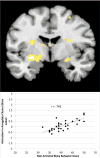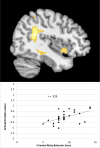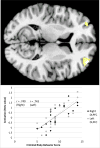Brain activation covaries with reported criminal behaviors when making risky choices: A fuzzy-trace theory approach
- PMID: 29975093
- PMCID: PMC6044465
- DOI: 10.1037/xge0000434
Brain activation covaries with reported criminal behaviors when making risky choices: A fuzzy-trace theory approach
Abstract
Criminal behavior has been associated with abnormal neural activity when people experience risks and rewards or exercise inhibition. However, neural substrates of mental representations that underlie criminal and noncriminal risk-taking in adulthood have received scant attention. We take a new approach, applying fuzzy-trace theory, to examine neural substrates of risk preferences and criminality. We extend ideas about gist (simple meaning) and verbatim (precise risk-reward tradeoffs) representations used to explain adolescent risk-taking to uncover neural correlates of developmentally inappropriate adult risk-taking. We tested predictions using a risky-choice framing task completed in the MRI scanner, and examined neural covariation with self-reported criminal and noncriminal risk-taking. As predicted, risk-taking was correlated with a behavioral pattern of risk preferences called "reverse framing" (preferring sure losses over a risky option and a risky option over sure gains, the opposite of typical framing biases) that has been linked to risky behavior in adolescents and is rarely observed in nondisordered adults. Experimental manipulations confirmed processing interpretations of typical framing (gist-based) and reverse-framing (verbatim-based) risk preferences. In the brain, covariation with criminal and noncriminal risk-taking was observed predominantly when subjects made reverse-framing choices. Noncriminal risk-taking behavior was associated with emotional reactivity (amygdala) and reward motivation (striatal) areas, whereas criminal behavior was associated with greater activation in temporal and parietal cortices, their junction, and insula. When subjects made more developmentally typical framing choices, reflecting nonpreferred gist processing, activation in dorsolateral prefrontal cortex covaried with criminal risk-taking, which may reflect cognitive effort to process gist while inhibiting preferred verbatim processing. (PsycINFO Database Record
(c) 2018 APA, all rights reserved).
Figures




Similar articles
-
Neurobiological and memory models of risky decision making in adolescents versus young adults.J Exp Psychol Learn Mem Cogn. 2011 Sep;37(5):1125-42. doi: 10.1037/a0023943. J Exp Psychol Learn Mem Cogn. 2011. PMID: 21707215 Clinical Trial.
-
Critical tests of fuzzy trace theory in brain and behavior: uncertainty across time, probability, and development.Cogn Affect Behav Neurosci. 2023 Jun;23(3):746-772. doi: 10.3758/s13415-022-01058-0. Epub 2023 Feb 24. Cogn Affect Behav Neurosci. 2023. PMID: 36828988 Free PMC article.
-
Risk and Rationality in Adolescent Decision Making: Implications for Theory, Practice, and Public Policy.Psychol Sci Public Interest. 2006 Sep;7(1):1-44. doi: 10.1111/j.1529-1006.2006.00026.x. Epub 2006 Sep 1. Psychol Sci Public Interest. 2006. PMID: 26158695
-
[Risk-taking in adolescence: A neuroeconomics approach].Encephale. 2010 Apr;36(2):147-54. doi: 10.1016/j.encep.2009.06.004. Epub 2009 Sep 22. Encephale. 2010. PMID: 20434632 Review. French.
-
Fuzzy-trace theory: dual processes in memory, reasoning, and cognitive neuroscience.Adv Child Dev Behav. 2001;28:41-100. doi: 10.1016/s0065-2407(02)80062-3. Adv Child Dev Behav. 2001. PMID: 11605365 Review.
Cited by
-
When Irrational Biases Are Smart: A Fuzzy-Trace Theory of Complex Decision Making.J Intell. 2018 Jun 8;6(2):29. doi: 10.3390/jintelligence6020029. J Intell. 2018. PMID: 31162456 Free PMC article.
-
Explaining risky choices with judgments: Framing, the zero effect, and the contextual relativity of gist.J Exp Psychol Learn Mem Cogn. 2021 Jul;47(7):1037-1053. doi: 10.1037/xlm0001016. Epub 2021 Apr 29. J Exp Psychol Learn Mem Cogn. 2021. PMID: 33914575 Free PMC article.
-
How Fuzzy-trace Theory Predicts Development of Risky Decision Making, with Novel Extensions to Culture and Reward Sensitivity.Dev Rev. 2021 Dec;62:100986. doi: 10.1016/j.dr.2021.100986. Epub 2021 Sep 9. Dev Rev. 2021. PMID: 34776580 Free PMC article.
-
A scientific theory of gist communication and misinformation resistance, with implications for health, education, and policy.Proc Natl Acad Sci U S A. 2021 Apr 13;118(15):e1912441117. doi: 10.1073/pnas.1912441117. Epub 2020 Apr 20. Proc Natl Acad Sci U S A. 2021. PMID: 32312815 Free PMC article. Review.
-
Supporting Health and Medical Decision Making: Findings and Insights from Fuzzy-Trace Theory.Med Decis Making. 2022 Aug;42(6):741-754. doi: 10.1177/0272989X221105473. Epub 2022 Jun 23. Med Decis Making. 2022. PMID: 35735225 Free PMC article.
References
-
- Banich MT, Crowley TJ, Thompson LL, Jacobson BL, Liu X, Raymond KM, Claus ED. Brain activation during the Stroop task in adolescents with severe substance and conduct problems: A pilot study. Drug and Alcohol Dependence. 2007;90(2):175–182. doi: 10.1016/j.drugalcdep.2007.03.009. - DOI - PMC - PubMed
MeSH terms
Grants and funding
LinkOut - more resources
Full Text Sources
Other Literature Sources
Research Materials

